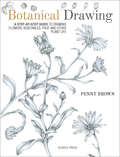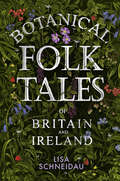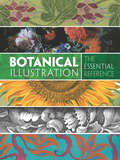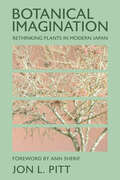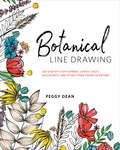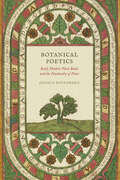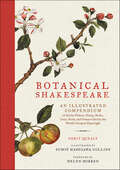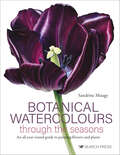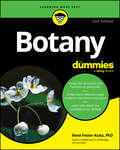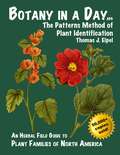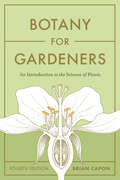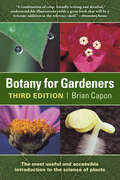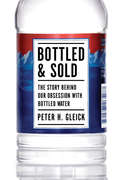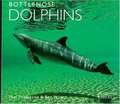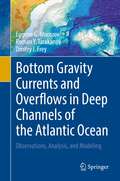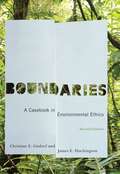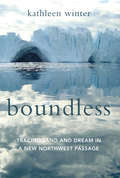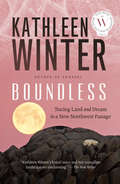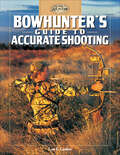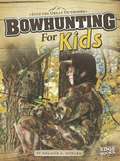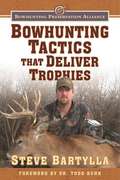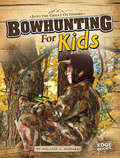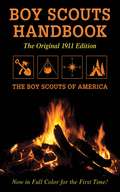- Table View
- List View
Botanical Drawing: A Step-By-Step Guide to Drawing Flowers, Vegetables, Fruit and Other Plant Life
by Penny BrownThe definitive artist's guide to drawing detailed and accurate plants, flowers and other vegetation in pencil—including illustrations and exercises.Botanical Drawing provides a thorough and expert guide to the subject, touching on the history of this fascinating art form as well as its rules and practicalities. Artist Penny Brown explains the materials, learnings and techniques required to produce accurate botanical illustrations. She also includes an accessible, basic study of botany for the absolute beginner.By following Brown’s step-by-step instructions, close studies and explorations of the subjects, you will be able to produce your own illustrations of plants, flowers, vegetables and their myriad parts. Botanical Drawing offers knowledge, techniques, and inspiration as you create your own projects.
Botanical Folk Tales of Britain and Ireland
by Lisa SchneidauThe islands of Britain and Ireland hold a rich heritage of plant folklore and wisdom, from the magical yew tree to the bad-tempered dandelion. Here are traditional tales about the trees and plants that shape our landscapes and our lives through the seasons. They explore the complex relationship between people and plants, in lowlands and uplands, fields, bogs, moors, woodlands and towns. Suitable for all ages, this is an essential collection of stories for anyone interested in botany, the environment and our living heritage.
Botanical Illustration: The Essential Reference
by Carol Belanger GraftonComprising more than 500 years of printed botanical illustrations, this stunning compendium of black-and-white and color images begins with medieval illuminated manuscripts and woodcuts from the early days of printing. In addition to images from the fifteenth and sixteenth centuries, the collection features highlights from such seventeenth-century classics as Gerard's Herbal, Besler's Hortus Eystettensis, and Crispin van de Pass' Hortus Floridus. Latter-day selections include illustrations from major nineteenth-century works -- including the great flower prints of Pierre-Joseph Redouté and hand-colored lithographs by many other artists of the period -- as well as the imaginative twentieth-century floral work in the Art Nouveau style of M. P. Verneuil, E. A. Seguy, and others.Detailed bibliographical information concerning every source and biographical information on the artists make this volume a vital reference tool as well as a splendid resource of significant and beautiful botanical illustrations. Students of graphic art and illustration as well as graphic designers, advertising professionals, and horticulturalists will prize this treasury of material from many rare historic sources.
Botanical Imagination: Rethinking Plants in Modern Japan (The Environments of East Asia)
by Jon L. PittBotanical Imagination explores the complicated legacy and enduring lure of plant life in modern Japanese literature and media. Using critical plant studies, Jon L. Pitt examines an unlikely group of writers and filmmakers in modern Japan, finding in their works a desire to "become botanical" in both content and form. For nearly one hundred years, a botanical imagination grew in response to moments of crisis in Japan's modern history.Pitt shows how artists were inspired to seek out botanical knowledge in order to construct new forms of subjectivity and attempt to resist certain forms of state violence. As he follows plants through the tangled histories of imperialism and state control, Pitt also uncovers the ways plants were used in the same violence that drove artists to turn to the botanical as a model of resistance in the first place. Botanical Imagination calls on us to rethink plants as significant but ambivalent actors and to turn to the botanical realm as a site of potentiality.
Botanical Line Drawing: 200 Step-by-Step Flowers, Leaves, Cacti, Succulents, and Other Items Found in Nature
by Peggy DeanFrom the artist behind the popular Pigeon Letters website, an easy, no-skills-necessary guide to drawing flowers, leaves, and cacti with 200 step-by-step prompts.Line drawing is an easy-to-master art form featuring illustrative, doodle-like designs. It's used widely among artists of many types with both fine and bold lines, creating different variations. Botanical Line Drawing teaches you how to start with the simplest doodles, building into more elaborate, delicate illustrations. This book focuses on the extremely popular subject matter of the natural world and includes flowers, leaves, succulents, houseplants, trees, branches, mushrooms, and more. These simple line drawings will allow you to branch out and have fun with your own personal style, as well as inspire you to add flourishes to other projects.
Botanical Poetics: Early Modern Plant Books and the Husbandry of Print
by Jessica RosenbergDuring the middle years of Queen Elizabeth’s reign, the number of books published with titles that described themselves as flowers, gardens, or forests more than tripled. During those same years, English printers turned out scores of instructional manuals on gardening and husbandry, retailing useful knowledge to a growing class of literate landowners and pleasure gardeners. Both trends, Jessica Rosenberg shows, reflected a distinctive style of early modern plant-thinking, one that understood both plants and poems as composites of small pieces—slips or seeds to be recirculated by readers and planters.Botanical Poetics brings together studies of ecology, science, literary form, and the material text to explore how these developments transformed early modern conceptions of nature, poetic language, and the printed book. Drawing on little-studied titles in horticulture and popular print alongside poetry by Shakespeare, Spenser, and others, Rosenberg reveals how early modern print used a botanical idiom to anticipate histories of its own reading and reception, whether through replanting, uprooting, or fantasies of common property and proliferation. While our conventional narratives of English literary culture in this period see reading as an increasingly private practice, and literary production as more and more of an authorial domain, Botanical Poetics uncovers an alternate tradition: of commonplaces and common ground, of slips of herbs and poetry circulated, shared, and multiplied.
Botanical Shakespeare: An Illustrated Compendium of all the Flowers, Fruits, Herbs, Trees, Seeds, and Grasses Cited by the World's Greatest Playwright
by Gerit QuealyA captivating, beautifully illustrated, one-of-a-kind color compendium of the flowers, fruits, herbs, trees, seeds, and grasses cited in the works of the world’s greatest playwright, William Shakespeare, accompanied by their companion quotes from all of his plays and poems. With a foreword by Dame Helen Mirren—the first foreword she has ever contributed.In this striking compilation, Shakespeare historian Gerit Quealy and respected Japanese artist Sumié Hasegawa combine their knowledge and skill in this first and only book that examines every plant that appears in the works of Shakespeare.Botanical Shakespeare opens with a brief look at the Bard’s relationship to the plants mentioned in his works—a diversity that illuminates his knowledge of the science of botany, as well as the colloquy, revealing his unmatched skill for creating metaphorical connections and interweaving substantive philosophy. At the heart of the book are "portraits" of the over 170 flowers, fruits, grains, grasses, trees, herbs, seeds and vegetables that Shakespeare mentions in his plays and poems. Botanical Shakespeare features a gorgeous color illustration of each, giving a "face" to the name, alongside the specific text in which it appears and the character(s) who utter the lines in which it is mentioned.This fascinating visual compendium also includes a dictionary describing each plant—such as Eglantine, a wild rose with a slight prickle, cherished for its singular scent, superior to any other rose; and the difference between apples and apple-john—along with indices listing the botanical by play/poem, by character, and genus for easy reference, ideal for gardeners and thoughtful birthday gift-giving.This breathtaking, incomparable collection of exquisite artwork and companion quotes offers unique depth and insight into Shakespeare and his timeless work through the unusual perspective of the plants themselves.
Botanical Watercolours through the seasons: An All-Year-Round Guide to Painting Flowers and Plants
by Sandrine MaugyThis stunning book follows the rhythm of nature through the year.Botanical Watercolours through the Seasons begins with a detailed introduction to Sandrine's ethically-sourced materials and tools, her workspace and an exploration of the key techniques employed in painting botanical watercolours. Sandrine explains colour theory in relation to botanical subjects, as well as colour bias and the key to creating realistic shadows without resorting to an unnatural 'grey'. The four main chapters focus on a particular season and contains techniques for painting its plants: for example, papery bulbs in spring and jewel-like berries in winter, along with examples of the author’s stunning botanical artwork. Each chapter includes three step-by-step tutorials: the first for relative beginners; the second for artists of intermediate level and the third for more experienced artist. Subjects range from bold spring daffodils, delicate summer sweet peas, through to whimsical autumn ginkgo biloba leaves, and finishing with a striking holly star composition to close the winter chapter.With a foreword from Tom Brown, Head Gardener at West Dean College of Arts and Conservation: "It is Sandrine’s botanical knowledge that sets her apart, [...] through [her] guidance we can learn to celebrate and document the natural rhythms of our green spaces around us." Readers can work through the book season-by-season, or focus on the plants they know and love. All the recommended materials used in the book are ethically sourced: the paper is from sustainable sources, the brushes are cruelty-free and the paints are vegan.
Botany For Dummies
by Rene Fester KratzHarvest basic botany knowledge from this abundant book Botany For Dummies gives you a thorough overview of the fundamentals of botany, but in simple terms that anyone can understand. Great for supplementing your botany coursework or brushing up before an exam, this book covers plant evolution, the structure and function of plant cells, and plant identification. Plus, you'll learn about how plants of different types are changing and adapting in response to changing climates. This new edition goes into more detail on fungi—not technically plants, but no one is holding that against them. Regardless of what brought you to the wonderful world of botany, this book will show you around. Get an easy-to-understand introduction to the key concepts in botany Read about recent discoveries and theories in the world of plant science Understand different families of plants and where they grow Improve your grade and pass your exam in your introductory botany course Get a copy of Botany For Dummies and watch your botany knowledge bloom.
Botany In A Day: The Patterns Method of Plant Identification
by Thomas ElpelRelated plants have similar characteristics, and they often have similar uses. Rather than learning new plants one-at-a-time, it is possible to learn them by the hundreds, based on plant family patterns. Each family of related plants has unique patterns for identification. Learn to recognize these patterns, and discover them again and again in the plants you encounter. It is possible to instantly recognize a plant never before seen, and in many cases, to know its edible or medicinal properties on the spot-even before you have identified it down to the species! Botany in a Day is changing the way people learn about plants. A one-day tutorial introduces eight of the world's most common plant families, applicable to more than 45,000 species of plants. Master these eight patterns and have the skills to recognize an astonishing number of plants on any continent. Add to your repertoire by keying out entirely unknown plants and learning additional family patterns. Botany in a Day is principally written for North America, but used and adored by readers all over the world. It is used as a textbook in numerous universities, high schools, and herbal schools. This book is widely used in nature programs and promoted in national parks. Botany in a Day is your passport connection to nature and discovering the amazing world of plants!
Botany for Gardeners, Fourth Edition: An Introduction to the Science of Plants
by Brian Capon&“This should be the cornerstone of every gardener&’s library.&” —Jeff Gillman, Director of the UNC Charlotte Botanical Gardens What happens inside a seed after it is planted? How are plants structured? How do plants reproduce? The answers to these and other questions about complex plant processes can be found in the bestselling Botany for Gardeners. First published in 1990 with more than 260,000 copies sold, it has become the go-to introduction to botany for students and gardeners. Now in its fourth edition, Botany for Gardeners has been expanded and updated. It features a revised interior, with new photos and illustrations that clarify the concepts clearer than ever before. Additional updates address scientific advances, changes in nomenclature and taxonomy, and more. As before, Botany for Gardeners shares accessible information about how plants are organized, how they have adapted to nearly all environments on earth, their essential functions, and how they reproduce.
Botany for Gardeners: Third Edition (Science For Gardeners Ser.)
by Brian CaponA bestseller since its debut in 1990, this indispensable and handy reference has now been expanded and updated to include an appendix on plant taxonomy and a comprehensive index. Two dozen new photos and illustrations make this new edition even richer with information. Its convenient paperback format makes it easy to carry and access, whether you are in or out of the garden. An essential overview of the science behind plants for beginning and advanced gardeners alike.
Bottled and Sold: The Story Behind Our Obsession with Bottled Water
by Peter H. GleickPeter Gleick knows water. A world-renowned scientist and freshwater expert, Gleick is a MacArthur Foundation "genius," and according to the BBC, an environmental visionary. And he drinks from the tap. Why don't the rest of us? Bottled and Sold shows how water went from being a free natural resource to one of the most successful commercial products of the last one hundred years--and why we are poorer for it. It's a big story and water is big business. Every second of every day in the United States, a thousand people buy a plastic bottle of water, and every second of every day a thousand more throw one of those bottles away. That adds up to more than thirty billion bottles a year and tens of billions of dollars of sales. Are there legitimate reasons to buy all those bottles? With a scientist's eye and a natural storyteller's wit, Gleick investigates whether industry claims about the relative safety, convenience, and taste of bottled versus tap hold water. And he exposes the true reasons we've turned to the bottle, from fearmongering by business interests and our own vanity to the breakdown of public systems and global inequities. "Designer" H2O may be laughable, but the debate over commodifying water is deadly serious. It comes down to society's choices about human rights, the role of government and free markets, the importance of being "green," and fundamental values. Gleick gets to the heart of the bottled water craze, exploring what it means for us to bottle and sell our most basic necessity.
Bottlenose Dolphins (WorldLife Library)
by Paul Thompson Ben WilsonIntelligent, graceful and approachable, dolphins have long been among the worlds favorite sea creatures. Of all the dolphin species, the bottlenose is best known and loved. But bottlenose dolphins are more than television stars and aquarium performers. In Bottlenose Dolphins readers will voyage under the sea with researchers Paul Thompson and Ben Wilson, who are studying dolphins off the coast of Scotland. The authors explain the bottlenose dolphins oceanic habitat and range, and delve into their complex social relationships. They also share their concerns for the future of these beloved seafarers and suggest steps to protect them. Stunning color photographs accompany their insights.
Bottom Gravity Currents and Overflows in Deep Channels of the Atlantic Ocean: Observations, Analysis, and Modeling
by Eugene G. Morozov Roman Y. Tarakanov Dmitry I. FreyThis book is dedicated to the analysis of bottom waters flows through underwater channels of the Atlantic Ocean. The study is based on recent observations of the authors, analysis of historical data, numerical modeling, and literature review. For example, studying both the measurements from the World Ocean Circulation experiment in the 1990s and recent measurements reveals the decadal variations of water properties in the ocean.Seawater is cooled at high latitudes, descends to the ocean bottom, and slowly flows to the tropical latitudes and further. This current is slow in the deep basins, but intensifies in the abyssal channels connecting the basins. The current overflows submarine topographic structures and sometimes forms deep cataracts when water descends over slopes by several hundred meters. The flow of Antarctic Bottom Water (AABW) is studied on the basis of CTD sections combined with Lowered Acoustic Doppler Profiling (LADCP) carried out annually, and long-term moored measurements of currents. This book is a collection of oceanographic data, interpretation, and analysis, which can be used by field oceanographers, specialists in numerical modeling, and students who specialize in oceanography.
Boundaries: A Casebook in Environmental Ethics
by Christine E. Gudorf James Edward HuchingsonIn this expanded and revised edition of a fresh and original case-study textbook on environmental ethics, Christine Gudorf and James Huchingson continue to explore the line that separates the current state of the environment from what it should be in the future. <p> Boundaries begins with a lucid overview of the field, highlighting the key developments and theories in the environmental movement. Specific cases offer a rich and diverse range of situations from around the globe, from saving the forests of Java and the use of pesticides in developing countries to restoring degraded ecosystems in Nebraska. With an emphasis on the concrete circumstances of particular localities, the studies continue to focus on the dilemmas and struggles of individuals and communities who face daunting decisions with serious consequences. This second edition features extensive updates and revisions, along with four new cases: one on water privatization, one on governmental efforts to mitigate global climate change, and two on the obstacles that teachers of environmental ethics encounter in the classroom. Boundaries also includes an appendix for teachers that describes how to use the cases in the classroom.
Boundless: Tracing Land and Dream in a New Northwest Passage
by Kathleen WinterIn 2010, bestselling author Kathleen Winter (Annabel) embarked on a journey across the storied Northwest Passage, among marine scientists, historians, archaeologists, anthropologists, and curious passengers. <P><P>From Greenland to Baffin Island and all along the passage, Winter bears witness to the new math of the North-where polar bears mates with grizzlies, creating a new hybrid species; where the earth is on the cusp of yielding so much buried treasure that five nations stand poised to claim sovereignty of the land; and where the local Inuit population struggles to navigate the tension between taking part in the new global economy and defending their traditional way of life.Throughout Winter's journey, she learns from fellow passengers such as Aaju Peter and Bernadette Dean, who teach her about Inuit society (both past and present). She bonds with Nathan Rogers, son of the late Canadian icon Stan Rogers, who died in a plane crash when Nathan was just a young boy. Nathan's quest is to take the route his father never traveled, expect in his beloved song "The Northwest Passage," which he performs both as anthem and lament at sea. And she guides readers through her own personal odyssey, emigrating from England to Canada as a child and discovering both what was lot and what was gained as a result of that journey.In breathtaking prose charged with vivid descriptions of the land and its people, Kathleen Winter's Boundless is a haunting and powerful homage to the ever-evolving and magnetic power of the North.
Boundless: Tracing Land and Dream in a New Northwest Passage
by Kathleen WinterThe long-awaited follow up to Annabel and Kathleen Winter’s first work of narrative nonfiction.In 2010, bestselling author Kathleen Winter took a journey across the storied Northwest Passage, among marine scientists, historians, archaeologists, anthropologists, and curious passengers. From Greenland to Baffin Island and all along the passage, Winter bears witness to the new math of the melting North — where polar bears mate with grizzlies, creating a new hybrid species; where the earth is on the cusp of yielding so much buried treasure that five nations stand poised to claim sovereignty of the land; and where the local Inuit population struggles to navigate the tension between taking part in the new global economy and defending their traditional way of life.Throughout the journey she also learns from fellow passengers Aaju Peter and Bernadette Dean, who teach her about Inuit society, past and present. She bonds with Nathan Rogers, son of the late Canadian icon Stan Rogers, who died in a plane crash when Nathan was nearly four years old. Nathan’s quest is to take the route his father never travelled, except in his beloved song “The Northwest Passage,” which he performs both as anthem and lament at sea. And she guides us through her own personal odyssey, emigrating from England to Canada as a child and discovering both what was lost and what was gained as a result of that journey.In breathtaking prose charged with vivid descriptions of the land and its people, Kathleen Winter’s Boundless is a haunting and powerful story, and a homage to the ever-evolving and magnetic power of the North.
Bowhunter's Guide to Accurate Shooting (The Complete Hunter)
by Lon E. LauberPerfect your bowhunting technique with this comprehensive guide covering equipment, skill-building, and field-tested tips for taking down big game.Most hunters agree that bowhunting is a low-percentage affair. To improve your chances in the field, it’s crucial that you choose the right equipment, set it up properly, and have the necessary skill to use it when the moment of truth comes. In this guide, expert archer and bowhunter Lon E. Lauber gives you the knowledge and techniques you need to drastically improve your accuracy.Whether you’re working with a compound bow, recurve or longbow, Lauber helps you understand your weapon. He then offers in-depth advice on how to practice good shooting form. This is followed by a discussion field skills such as balancing accuracy and speed and maintaining mental focus, and shooting in adverse conditions.
Bowhunting For Kids
by Melanie A. HowardYou spot a huge deer coming closer to you. You quietly raise your bow. Do you have what it takes to bring the big animal down? Now is your chance to learn what you need to know about bowhunting history, gear, techniques, safety, and more.
Bowhunting Tactics That Deliver Trophies: A Guide to Finding and Taking Monster Whitetail Bucks
by Steve Bartylla Todd KuhnSteve Bartylla gets down to the nuts and bolts of what it takes to bowhunt public land whitetails today. Bartylla consistently proves that hard work, an in-depth understanding of whitetail deer and how they use terrain—combined with an ability to read aerial photographs and interpret contour maps to find pockets where mature bucks exist—are the necessary tools for a bowhunter's success. In Bowhunting Tactics That Deliver Trophies, you will find excellent advice on determining what food sources are hot during different times of the year, inside tips on what really happens when hunting with wind in your face, and how to get the most from each and every tree stand. Bartylla also shares savvy advice on hunting from ground blinds, how to maximize your time when hunting public land, and the most effective trailing tools to find your buck. Whether you are just beginning to hunt with a bow or you are a seasoned bowhunter, you will find a tremendous amount of information that you can use each and every deer season.
Box Turtles and Other Pond and Marsh Turtles (World Book's Animals of the World)
by Christina JohnsonIntroduces the box turtle and talks about keeping one as a pet.
Boy Scout Handbook (11th edition)
by Robert BirkbyThe Eleventh Edition of the Boy Scout Handbook. The official handbook of the Boy Scouts of America.
Boy Scouts Handbook: Original 1911 Edition
by Boy Scouts of AmericaThis is a facsimile reprint of the very first Boy Scouts Handbook, complete with the wonderful vintage advertisements that accompanied the original 1911 edition, now in full color. Over 40 million copies of this book have been distributed since its first publication nearly 100 years ago.The original Boy Scouts Handbook standardized American scouting and emphasized the virtues and qualifications for scouting, delineating what the American Boy Scouts declared was needed to be a "well-developed, well-informed boy." The book includes information on the organization of scouting, signs and signaling, camping, scouting games, and a description of several scouting honors. Scouts past and present will be fascinated to see how scouting has changed, as well as what has stayed the same over the years.
